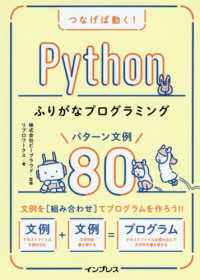Full Description
Sherylyn Briller and Amy Goldmacher's Designing an Anthropology Career: Professional Development Exercises, Second Edition, provides undergraduate and graduate students with the tools they need to identify their career goals and follow through on them. Part I establishes a framework on how to begin designing a career in anthropology or other related fields. Part II contains a series of professional development exercises to help readers articulate their personal and professional histories, special abilities, and career goals. Each exercise is followed by a sample completed by an anthropology student or anthropologist to provide models for readers to complete their own exercises, which will be invaluable tools for choosing the right career. Throughout the text, the authors take a broad perspective to encourage readers to imagine an evolving anthropology career as a lifetime endeavor.
Contents
Table of Contents:
Part I - Desigining An Anthropology Career
Chapter 1 Introduction
Updated discussion of 21st century world of work, roles for liberal arts graduates and the power of an anthropology degree
New section about practitioners/employment in anthropological practice
Updated personal story boxes of the authors based on career changes since the first edition
Updated content based on what students have been asking for (e.g., how to become an anthropological practitioner, how to ensure that students can set up to work on social issues about which they care most)
Chapter 2 Positioning Yourself in the Discipline
Tone adjusted to accommodate undergraduates and graduate level students and for professionals who may be looking to pivot careers
Updated discussion of the state of anthropology education; applied/practice, academic spectrum; changes to tenure and promotion standards in academia to reflect growing influence of applied scholarship, pedagogy and engagement
Updated discussion of how applied/practicing anthropology has grown and evolved - and the doors that have been opened over time
Updated discussion of the life course approach to career planning
Chapter 3 How to Use this Book Effectively
Updated discussion of technologies and storage practices and feedback mechanisms
Part II - Professional Development Exercises
All exercises will be enhanced and updated to include more specific direction with the prompts, tips for completion, applicability to real-life situations, new examples and action plans.
Two exercises (Representing Your Body of Work: Portfolio Exercise and Representing Yourself in Other Fields: Second Domain Exercise) have been renamed "Term Projects" because they require more effort over a longer time period and are well-suited for midterm and/or final projects in a course. As such, they will be substantially reworked and reformatted to reflect how students should approach and work on these larger activities. Emphasis will be placed on other kinds of deliverables - e.g., a portfolio you can share with potential employers or use for representing yourself on the Internet. For the Second Domain exercise, we have found that one of the best outcomes is that this project causes students to reach out in a series of informational interviews to individuals they would like to add to their professional network. This step has resulted in numerous positive developments including growing these networks and sometimes even leading to job opportunities. We want to maximize the value of these larger exercises in some of these key ways.
Exercise 1 - Understanding Yourself as an Anthropologist: Identity Exercise
Exercise 2 - Understanding Your Educational Background: Transcript Exercise
Exercise 3 - Understanding Your Work Background: Job Titles Exercise
Exercise 4 - Understanding Your Values: Code of Ethics Exercise
Exercise 5 - Understanding Your Impact: Making Social Change Exercise
Exercise 6 - Understanding Yourself in Collaboration: Team Work Exercise
Exercise 7 - Understanding Your Personal and Professional Balance: Lifestyle Exercise
Exercise 8 - Understanding Your Advising Relationships: Mentorship Exercise
Exercise 9 - Understanding Your Professional Connections: Networking Exercise
Exercise 10 - Understanding Your Ideal Job: Anthropological Job Search Exercise
Exercise 11 - Representing Yourself Professionally as an Anthropologist: Personal Introduction Exercise
Exercise 12 - Representing Yourself in a Summary Document: Resume Exercise
Exercise 13 - Representing Your Whole Anthropological Career: Retirement Exercise
Term Project 1 - Representing Your Body of Work: Portfolio Exercise
Term Project 2 - Representing Yourself in Other Fields: Second Domain Exercise
References
About the Authors








